-
收藏模板
- 模板信息
- 更新时间:2023-09-08
- 字数:约34688字
- 页数:约28页
- 格式:.doc
- 推荐版本:Office2016及以上版本
- 售价:5 金币
您可能喜欢的文档

人教版新目标初中英语八年级上册How do you make a banana milk shake说课稿8篇
(五)教学过程1)在课的开始检查学生对单词短语的掌握2)1b,听力为了让学生了解香蕉奶的制作过程,让学生复述,是为了然他们用所学的重点 词汇进行练习、为后面制作水果沙拉奠定基础。3)2a2b的听力是为了复习how much 与how many的区别 ,因为七年级上册unit8涉及到的知识,所以2a2b训练的的真正目的是为了让学生更清楚的了解不可数名词的表达方式 :数词+量词 +of+不可数名词4)在学生完全弄懂事物的制作过程极其不可数名词的数量表达后,我安排他们进行制作水果沙拉的对话。这个对话是机动的,如果时间充足,我让他们按照自己的医院去选择材料进行对话的编排。这个话题既可以用到本科的重点句型,又可用到重点词汇。在这步抓住重点突出难点5)在consolidate 环节,我安排2个汉译英,4个有关how much/how many 的选择,让学生讲做题原因,让他们彻底弄懂不可数名词的数量表达。6)最后,为了加深学生对食物制作过程描述的巩固,让学生把所学知识从口落实到笔头

人教版新目标初中英语八年级上册How do you get to school教案2篇
Step Ⅶ Role play ( Work on 1b)1. First ask two students to read the dialogue to the class.Sa: How do you get to school?Sb: Well, I ride my bike to the subway station. Then I take the subway.2. Now work with a partner.Suppose you use two kinds of transportation to get to school \Hangzhou\Beijing... (bus, train, subway, walking, bike, etc.) Tell how you get there. You may use the phrases in 1a.3. Then ask different pairs of students to present their conversations to the class.Step ⅧListening1. Work on 2a(1) First ask students to read the list of information that Thomas wants to know.…where Nina lives.…how far from school she lives.…how long it takes to get to school.…how she gets to school.…what she thinks of the transportation.(2) Tell students what transportation and bus stop mean.bus stop 汽车站 transportation n. 运送;运输Then tell students we'll hear a recording. Please put a checkmark in front of each thing that Thomas wants to know.(3) Now play the recording for students.( Have students pay attention to the sample answer.) (4) Then correct the answers.
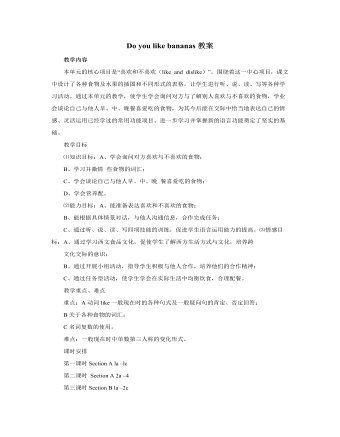
人教版新目标初中英语七年级上册Do you like bananas教案
教学目标 ⑴知识目标:A、学会询问对方喜欢与不喜欢的食物; B、学习并激情 些食物的词汇; C、学会谈论自己与他人早、中、晚 餐喜爱吃的食物; D、学会营养配。 ⑵能力目标:A、能准备表达喜欢和不喜欢的食物; B、能根据具体情景对话,与他人沟通信息,合作完成任务; C、通过听、说、读、写四项技能的训练,促进学生语言运用能力的提高。⑶情感目标:A、通过学习西文食品文化,促使学生了解西方生活方式与文化,培养跨 文化交际的意识; B、通过开展小组活动,指导学生积极与他人合作,培养他们的合作精神; C、通过任务型活动,使学生学会在实际生活中均衡饮食,合理配餐。 教学重点、难点 重点:A动词like一般现在时的各种句式及一般疑问句的肯定、否定回答; B关于各种食物的词汇; C名词复数的使用。 难点:一般现在时中单数第三人称的变化形式。
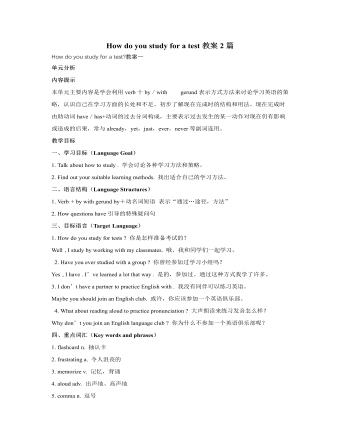
人教版新目标初中英语九年级上册How do you study for a test教案2篇
内容提示本单元主要内容是学会利用verb十by/with gerund表示方式方法来讨论学习英语的策略,认识自己在学习方面的长处和不足。初步了解现在完成时的结构和用法。现在完成时由助动词have/has+动词的过去分词构成,主要表示过去发生的某一动作对现在仍有影响或造成的后果,常与already,yet,just,ever,never等副词连用。教学目标一、学习目标(Language Goal) 1. Talk about how to study . 学会讨论各种学习方法和策略。2. Find out your suitable learning methods. 找出适合自己的学习方法。 二、语言结构(Language Structures) 1. Verb + by with gerund by+动名词短语 表示“通过…途径,方法” 2. How questions have引导的特殊疑问句 三、目标语言(Target Language) 1. How do you study for tests ? 你是怎样准备考试的?Well , I study by working with my classmates. 哦,我和同学们一起学习。2. Have you ever studied with a group ? 你曾经参加过学习小组吗?Yes , I have . I’ve learned a lot that way . 是的,参加过。通过这种方式我学了许多。
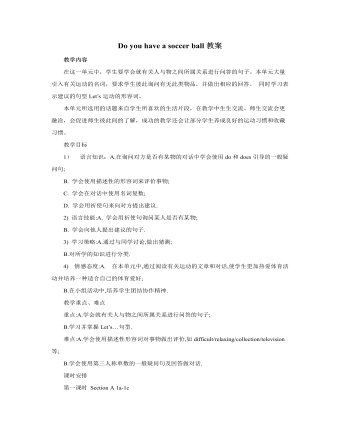
人教版新目标初中英语七年级上册Do you have a soccer ball教案
在这一单元中,学生要学会就有关人与物之间所属关系进行问答的句子。本单元大量引入有关运动的名词,要求学生彼此询问有无此类物品,并做出相应的回答。 同时学习表示建议的句型Let’s运动的形容词。 本单元所选用的话题来自学生所喜欢的生活片段,在教学中生生交流、师生交流会更融洽,会促进师生彼此间的了解,成功的教学还会让部分学生养成良好的运动习惯和收藏习惯。 教学目标 1) 语言知识:A.在询问对方是否有某物的对话中学会使用do和does引导的一般疑问句; B. 学会使用描述性的形容词来评价事物; C. 学会在对话中使用名词复数; D. 学会用祈使句来向对方提出建议. 2) 语言技能:A. 学会用祈使句询问某人是否有某物; B. 学会向他人提出建议的句子. 3) 学习策略:A.通过与同学讨论,做出猜测;
- 查看更多相关Word文档
How do you make a banana milkshake教案2篇
How do you make a banana milk shake?教案一
I.Teaching objectives 单元教学目标

Skill Focus
| 听 | Listen to the process and the ingredients of making something |
说 | Describe the process of making something Talk about the culture of eating home and abroad | |
读 | Read a passage about recipe | |
写 | Write about the process and ingredients of making something Write instructions about how to eat Beijing Duck | |
功
能
句
式 | Describe a process and follow instructions How do you make a banana milk shake? First, peel the bananas and cut them up. Then pour the milk into the blender ... Next ... Finally ... | |
Language Focus
|
词
汇 | 1. 重点词汇 cut, up, peel, pour,into, instruction, top, check,ice cream, salt, sandwich, bread, butter, duck 2. 认读词汇 shake, milk shake, yogurt, watermelon, popcorn, popper, relish, lettuce, turkey, slice, green onion, sauce, pancake, blender, ingredient, amount, teaspoon, super, recipe, mix, boil, add, roll 3. 短语 turn on, cut up, put/pour ... into ..., mix up, add ... to ... |
语
法 | 1. Imperatives (祈使句) Peel the bananas and cut them up. Pour the milk into the blender. 2. Countable/Uncountable nouns How many bananas do we need? There. How much yogurt do we need? Two cups. | |
Strategy Focus | Guessing Sequencing Task based learning | |
II.Teaching materials analyzing and rearranging 教材分析和教材重组
1.教材分析
本单元的中心话题是Cooking at home,主要围绕How do you make a banana milk shake?这一主题展开各种教学活动。并以这一主题引出可数名词和不可数名词,how many/how much 问句及祈使句等语言功能。本单元旨在让学生学会描述制作某个东西的过程和步骤,进而分析中西方在饮食文化方面的不同,通过听、说、读、写来培养学生综合运用这些知识的能力。最终让学生能在“做中学”(learning by doing),通过有限的课堂实践活动,能准确地用英语来表达。
SectionA 1a介绍本单元的重点词汇:一些用以描述香蕉饮料的制作过程的动词,并让学生根据图片选择正确的动词完成图中句子,由此引入本单元的主题;1b让学生听一段对话录音,根据听到的顺序给句子排序,帮助学生从听力材料中了解、获取目标语言;1c是一个口头会话练习(结对子活动),指导学生如何用目标语言进行对话(描述香蕉饮料的制作过程);2a和2b是两个听力活动,通过听力训练帮助学生进一步了解目标语言的用法,落实听与写的技能目标;2c是结对子口语会话活动,从描述如何制作香蕉饮料扩展到如何制作水果色拉,以巩固目标语言,是对学生的一种语言输出练习;3a要求学生阅读对话,并用所给的词完成对话,掌握几个表顺序的副词的用法;3b要求学生根据3a中的对话示范,看图向同伴描述爆米花的制作过程,帮助学生进一步用目标语言进行口头表达;4 是一个写食谱、拼食谱的游戏活动,给学生提供了一个学以致用的机会,是学生运用目标语言进行听、说、读、写的综合训练。
SectionB 1a让学生写出自己喜欢的三明治配料并与其他学生比较,学习一些表食品的词汇,为后面的课堂活动作铺垫;1b是在1a基础上的口头训练,仿照对话与同伴谈论喜欢的三明治配料;2a和2b是两个听力练习,其中2b也有写的训练;2c又是一个结对子口头会话练习,要求学生描述自己最喜欢的三明治的制作过程,是对目标语言的巩固与扩展; 3a、3b和3c为读、写训练,通过一系列活动了解中西方饮食文化的差异,其中3a是一篇关于Recipe的阅读材料,要求学生根据材料内容写出“Super Chicken Sandwich”的配料并进行分类完成表格,是一项巩固词汇的读写训练;3b是在3a的基础上的读与写的训练,完成 A recipe for Sandwich的阅读语言材料;3c用目标语言进行写作的训练,落实与巩固写的技能;4是一项口语训练活动,体现了英语语言“在做中学,在学中用”的特点,本单元的综合语言知识能力的运用在此体现出来。
Selfcheck 1 检验学生对几个重要动词和动词短语的掌握情况,形式为填空和造句;2 要求学生根据所给图片和提示语写一段吃北京烤鸭的步骤和过程,是对学生语言应用能力的综合检验。
2.教材重组和课时分配
Period1(Section A: 2a, 2b, Section B: 1a,1b)
Function,Listening and Speaking
Period2(Section A: 1a, 1b, 1c, 2c, 3a, 3b, 4)
Functionand Integrating skills
Period3(Section B: 2a, 2b, 2c, 3a, 3b, 3c)
Integratingskills and Culture
Period4(Self check and some exercises)
Grammarand Practice
III.Teaching plans for each period
How do you make abanana milk shake?教案二
Period 1 Function, Listening andSpeaking
Targetlanguage 目标语言
1.Words and phrases生词和短语
shake,watermelon, yogurt, teaspoon, blender, salt, popcorn, popper, sandwich, butter,relish, sauce, turkey, slice, green onion, duck, pancake, ingredient,instruction, amount
2.Key sentences重点句子
Howmany bananas do we need?
Howmuch milk do we need?
Abilitygoals 能力目标
Getstudents to know the names of food and drink, the plural forms of countablenouns, and uncountable nouns.
Learningability goals 学能目标
Helpstudents learn how to eat healthy.
Teachingimportant and difficult points 教学重难点
Theuse of countable nouns and uncountable nouns.
Teachingaids 教具准备
CAIor lantern slides, pictures, tape recording.
Teachingprocedures and ways 教学过程与方式
Step I Warming up
T:Good morning, boys and girls! Do you like English songs? Let’s relax ourselvesand enjoy an English song: “One hamburger, two hamburgers ...”(CAI呈现)
T:What’s the song about?
Ss:Food and drink.
T:Yeah, great! In this unit we’ll talk about how to make delicious food anddrink. (Write “How to make things” on the blackboard.) Today we willlearn the names of food and drink first.
Step II Guessing game and Presentation
T:Now please tell me what kind of food/drink/fruit you like.
S1:I like noodle.
S2:I like bananas.
S3:...
Inthis way, help students to review the words about food they have learned. Thenteach the following new words by using pictures or slides.
shake, watermelon, yogurt, teaspoon, blender, salt, popcorn, popper, sandwich, butter, relish, sauce, turkey, slice, green onion, duck, pancake |
Sample pictures:
StepIII Make chants
T:I have a good way to remember the words well. Now look at the slide and chantafter me.
Showthe following on the slide.
What do you like?What do you like? I like onions.I like. What does she like? What does she like? She likes yogurt.She likes. |
T:OK. Now make your own chants by changing the words underlined with the newwords that we have learned.
Studentsmake chants with each other, then ask individual students to present theirchants to the class and see who does it best.
Thenchoose the best chant maker and the best chanter.
Step IV Countable nouns and uncountablenouns
Showthe following words on the screen.
shake, watermelon, yogurt, teaspoon, blender, salt, popcorn, popper, sandwich, butter, relish, sauce, turkey, slice, green onion, duck, pancake, apple, ice cream, noodle, broccoli |
1.Put the words into the correct places
Countable nouns | Uncountable nouns |
|
|
|
|
T:Now please look at the words carefully. Then tell us which words can be countedand which words can not be counted. Put them in the right places in groups offour.
Afterthat have the students make a conclusion on the rules of plural forms ofcountable nouns and uncountable nouns. Finally sum up about the rules that:
Countableitems are things you can count like one apple, two apples, three bananas;Uncountable items are things you can’t count like milk or yogurt. So you shouldsay some milk/yogurt or two cups of milk/yogurt.
2.Pairwork
Aska student to act as partner, and present the following dialogue as a model.Then let students make more similar dialogues with the words above.
Model:
T:How many bananas do we need?
S:Three bananas.
T:How much relish do we need?
S:Two teaspoons.
Step V Listening (Section A: 2a, 2b)
Inthis step students will do some listening, speaking and writing practice usingthe target language.
T:Maria and Katie are making a fruit salad. Listen carefully to what they’re talkingabout.
Playthe recording for the first time. Students only listen.
T:They mentioned some names of foods, right? We call them ingredients. Look atthe chart in 2a on page 42. (Call attention to the headings “How much” and “Howmany”) Write the ingredients you can count under the heading “how many” andwrite those you can’t count under the heading “how much”.
Playthe recording again, students listen and write the names of the ingredients inthe correct column.
Checkthe answers.
Thenpoint at the chart in 2b and ask a student to read the amounts in the firstcolumn. Point out the measuring cup and teaspoon in the picture above.
T:Listen to the recording again. This time listen to the amount of eachingredient the girls talk about. Write the name of each ingredient after theamount in the chart.
Playthe recording again. Students write words in the correct places in theIngredient column.
Thencheck the answers.
T:Now look at the sample conversation in the picture. Which pair would like toread the conversation for us?
Asktwo students to read it to the class. Enable them to read in proper tone andintonation.
Thenlet students make similar dialogues with the ingredients and the amounts in thechart in pairs.
Finally,have some pairs present their dialogues.
Step VI My favorite (Section B: 1a, 1b)
Showthe followings on slide.
Discussion: What kind of salad/sandwich/popcorn/smoothie/ ... would you like to have? Write down the ingredients of your salad/sandwich/popcorn/smoothie/ ... Model: A: Do you like lettuce in sandwiches? B: Yes, I do. A: Do you like tomatoes? C: No, I don’t. A: Do you like relish? D: Yes, I do. Report: In my sandwich, I like lettuce, relish ... In his/her smoothie, he/she likes apples, oranges ... |
T:Now discuss in groups of four. Take turns to ask your partners what he or shelikes in sandwiches/popcorn/smoothie/ ... Each group can choose one food andtalk about it, then report to the class.
Finallymake a comment and choose:
※the best reporter
※the best salad
※the best smoothie
※the best sandwich
Step VII Summary and Homework
T:Today we have learned some names of food, what ingredients we need to makethings and how many/how much of them we need. Most of you talked about yourfavorite food as well. But I don’t think you can eat everything that you like.We should have healthy eating habit.
Homework:
Yourclass is having a party. You want to make some fruit salad and sandwiches. Soyour classmates and you are shopping. Yon are talking about what you need andthe amount.
Pleasemake a shopping list.
Shopping list | |
Ingredient(配料) | Amount(数量) |
Period 2 Function and Integratingskills
Targetlanguage 目标语言
1.Words and phrases生词和短语
peel,cut, pour, cut up, turn on, pour ... into, boil, add, add ... up, mix ... up,finally
2.Key sentences重点句子
(1)How do you make a banana milk shake?
First,peel the bananas and cut them up.
Thenput the milk into the blender ...
First... next ... then ... finally ...
(2)How do you make fruit salad?
(3)How do you make popcorn?
Abilitygoals 能力目标
Learnthe adverbs of procedure: first, next, after that, then, finally etc.
Talkabout making food.
Learningability goals 学能目标
Helpthe students learn how to describe a process with the target language.
Teachingimportant and difficult points 教学重难点
Describethe process of making something.
Teachingaids 教具准备
CAIor lantern slides, stick figures, tape recording.
Teachingprocedures and ways 教学过程与方式
Step I Verbs and instructions (Section A:1a, 1b)
Talkabout the picture on page 41.
T:Look at the picture carefully. What can you see? What are the boys doing?
Firsthave some individuals answer the question.
Clue:The picture shows some actions.
Thenhelp students to learn the meanings of the following verbs and verb phrases:
peel,cut, pour, cut up, turn on, pour ... into, boil, add, add ... up, mix ... up
Thenlet students do activity 1a.
Checkthe answers and let them remember the actions:
A.Drink the milk shake
B.Pour the milk into the blender
C.Peel the bananas
D.Cut up the bananas
E.Turn on the blender
F.Put the bananas and ice cream in the blender
T:From the picture, can you guess what they are doing?
Ss:They’re making a banana milk shake.
T:Yeah, you are clever. They are making smoothie.
Thendeal with the listening activity 1b. This activity gives students practice inunderstanding the target language in spoken conversation, especially students’ability of solving and analyzing information.
T:Now let’s do some listening. It’s about some instructions of making a bananamilk shake. First read the list of actions in activity 1b before listening.
Ss:(Read)
T:Do you know how to make banana milk shake? Can you put these instructions incorrect order? ... Now listen to the conversation, number the instructions inthe correct order.
Playthe recording. Students listen and number the instructions.
Playthe tape again. Students listen and check the answers.
Step IIPairwork (Section A: 1c)
T:Do you know how to make a banana milk shake now?
Ss:Yes.
Presentthe conversation with an individual as a model.
T:How do you make a banana milk shake, Xiao Li?
L:Peel the bananas, cut up the bananas, put the bananas and ice cream into theblender ...
Thenlet students practice the conversation in pairs without looking at theinstructions.
Step III Writing (Section A: 3a)
Thisactivity provides reading and writing practice using the target language.
T:Now let’s move on to 3a on page 43. First look at the picture carefully andanswer my question: What are the girl and the woman doing?
Ss:They are making fruit salad.
T:What ingredients can you see in the picture?
Ss:Apples, bananas, watermelon, honey and yogurt.
T:In the box, there are four words. Now read together. (...) We can use thesewords to describe a process. They tell the order of instructions. Which wordalways comes first?
Ss:First.
Askstudents to put number 1 next to the word “first”. Then ask them to number theother three words to show the order they appear in a process.
Clue:first → next → then → finally
T:Now please write these words in the blanks.
Checkthe answers.
Aska pair to read the conversation to the class.
Step IV Consolidation (Section A: 3b)
Thisactivity provides guided oral practice using the target language.
T:Next we will make another kind of food. Kids in America like that very much. Ithink you like it, too.
Showa picture of popcorn.
T:Look at my picture please. Do you like it? (...) I like it, too. It tastesdelicious. Now let’s go over some new words about the delicious food first.
Showthe following on the screen and let students repeat.
bowl n. 碗;钵 mix n. 混合物 mix up混合在一起 popcorn n. 玉米花 popper n. 爆米花机 sauce n. 调味汁;酱油 salt n. 盐 |
T:Now look at the pictures in activity 3b on page 43. Can you tell me what ishappening in Picture 1?
S:One of the boys puts the popcorn into the popper.
T:How about Picture 2? What do they do?
S:They turn on the popper.
Dealwith Pictures 3, 4, 5 in the same way.
T:Now you can work with a partner. Tell your partner how to make popcorn.
Thenask one or two students to tell the class how to make popcorn.
Sampleprocess of making popcorn:
First,put the popcorn into the popper.
Next,turn on the popper.
Then,pour the popcorn into the bowl.
Afterthat, put some salt on the popcorn.
Finally,enjoy it!
Step V Game (Section A: 4)
Thisactivity provides listening, speaking, reading, and writing practice using thetarget language.
T:Now let’s play a game. Get into group of four or six.
Helpstudents form teams and read the instructions to the class.
T:Now listen to me carefully and clearly. First decide on a dish or food yourgroup members all like. Then work out a recipe for it and write it down. Usethe words first, next, then, and finally in your recipe.
Asthe groups work on their recipes, move around the room checking their work.Help with names and amounts of ingredients as well as names of kitchen items.Also help students keep the vocabulary as simple as possible, using words thatthe class already know.
Remindthem to write each instruction on a separate line.
T:Now cut your recipe up. And exchange it with another group. Then put the recipeyou get in order. Are you clear?
Afew minutes later, ask the groups to check each other’s work. In the end, asksome groups to read their recipes to the class. Vote for the most creativefood.
Step VI Summary and Homework
T:This class we have learned how to make a banana milk shake, how to make fruitsalad and how to make popcorn. We also learned how to describe a process byusing “first, next, then and finally”. I hope you can make these foods at homeby yourselves. It will be fun.
Homework:
Searchfor information about the eating habits and culture in western countries.
Period 3 Integrating skills and Culture
Targetlanguage 目标语言
1.Words and phrases生词和短语
butter,turkey, slice, relish, lettuce, onion, sandwich, add, add ... up, mix ... up,finally
2.Key sentences重点句子
Howdo you make a sandwich?
First,put some relish on a slice of bread.
Thencut up some tomatoes ...
Finally,...
Abilitygoals 能力目标
Learnto write the process of making something.
Learningability goals 学能目标
Helpstudents learn how to describe the steps of making something in English correctly.
Teachingimportant and difficult points 教学重难点
Howto write a recipe.
Teachingaids 教具准备
CAI,tape recording.
Teachingprocedures and ways 教学过程与方式
Step I Revision and Presentation
T:Last class we learned how to make smoothie, fruit salad and popcorn. Do youremember the instructions of making them?
Askstudents to bring materials for making milk shake, salad or sandwich. Then havethe students talk about their favorite food.
Finally,three individuals describe the steps of making smoothie, fruit salad andpopcorn.
Showthe steps of making popcorn on the slide and have students read together.
Howto make popcorn:
First,put the popcorn into the popper.
Next,turn on the popper.
Then,pour the popcorn into the bowl.
Afterthat, put salt on the popcorn.
Finally,eat the popcorn!
T:Well done! This class we will make another different food. It is more deliciousand tasty, but more difficult to do. Now let’s learn some new words we will useto make a more delicious sandwich. Please look at the screen and read after me.
Showon the screen:
Wordsand meanings:
butter,turkey, slice, relish, lettuce, onion, sandwich,add, add ... up, recipe, mustard
add:put something on (doing action to show)
recipe:ways to cook food, with this we could cook food as easily as a real chef
mustard:something we put into salad or food to make more flavor
Step II Listening (Section B: 2a, 2b)
Showa picture of a sandwich.
T:Do you like it? What ingredients do we need to make it?
Ss:...
T:Now let’s look at activity 1a on page 44.
Pointto the food in activity 1a and read the words to the class.
T:You will hear some of these words on the tape. Now listen and circle the wordsthat you hear.
Playthe tape twice. Then check the answers.
Callattention to the chart in activity 2b.
T:Listen again carefully and write down the ingredients in the order you hearthem.
Playthe tape twice and then check the answers.
Step III Pairwork (Section B: 2c)
T:Have you got some ideas about how to make a turkey sandwich after listening?
Ss:...
T:Well, I will tell you more about it. First please take out a piece of paper.Then write down the things you use to make your favorite sandwiches. And don’tforget the amount. Clear?
Thenstudents write down the ingredients and amount they need for their favoritesandwich.
T:OK. Now work in pairs. Use your list of ingredients and amounts to tell yourpartner how to make your favorite sandwich. Remember to use the words “First,Next, Then, and Finally.”
Pointout the sample conversation on page 44 and have the students read it together.
Thenstudents make their own conversations.
Asksome pairs to present their conversations to the class in front.
Step IV Reading (Section B: 3a)
T:Now let’s read a recipe of making a super chicken sandwich.
Pointto the recipe and the chart below it.
T:We know onion is a kind of vegetable. What about tomato?
S:It’s a kind of vegetable, too.
T:Is chicken slice vegetable or meat?
S:Meat.
Pointto the words “Vegetables”, “Meat”, and “Others” in the chart. Ask students togive some examples for each type of food.
T:You are very clever. Now read the recipe and write the ingredients under“Vegetables”, “Meat”, and “others” in the chart below.
Thencheck the answers.
Thencall attention to the ingredients list. Let students underline the names ofingredients and circle the amounts. This will help them to review uncountablenouns and countable nouns.
bread→ two slices
butter→ 1 teaspoon
onion→ 1
tomato→ 1
chicken→ 3 slices
relish→ 2 teaspoons
Step V Writing (Section B: 3b, 3c)
1.Read the recipe and fill in the blanks with the words from the box.
T:There is another sandwich recipe. It’s for a great turkey sandwich. Read therecipe and fill in the blanks with the words from the box on the left.
Pointout the words in the box and ask a student to read the words to the class.
Checkthe answers.
2.Pairwork
Readthe instructions to the class. Then ask:
T:What should we do before we make some food?
Ss:Write out the ingredients.
T:Very good! Now write down the ingredients you need to make your favorite food,and then write your recipes. You can use the recipe in activity 3b as anexample.
Afterstudents have finished, ask them to read their recipes to their partners andcheck each other.
Finally,ask some students to read their recipes to the class.
Step VI Eating culture
Inthis step, students will learn something about the eating culture in the west.
Showthe followings on slide.
Differencesbetween the western and Chinese eating culture
1.Cooking ways
InChina:
Payattention to color, smell, taste; Cook with cooking pot, has much smoke;
Differentways of cooking: stew, braise, fry, instant boil, smoke; deep fry, simmer;
Inwestern countries:
Payattention to nutrition; Cook with oven, doesn’t have too much smoke;
Simplecooking ways: roast, bake, toast, boil;
2.Eating habits
InChina:
1)Eat with chopsticks.
2)Take vegetables from the same plate with own chopsticks.
Inwestern countries:
1)Eat with forks and knives.
2)Take food from own plate.
3.Eating manners
InChina:
1)People can talk loudly when they are eating.
2)People throw up the draffy after eating.
3)A guest in a Chinese house never finish the food, he leaves a little to showthat he has had enough.
Inwestern countries:
1)People speak softly when they are eating.
2)People never throw up the draffy.
3)In England, a guest always finishes a drink to show that he has enjoyed it.
4.Order of servings
InChina:
1)cold dishes and drinks
2)main courses—fish; crabs; shrimps; pork; chicken; vegetables
3)fruits
Inwestern:
1)starters—soup/cocktail
2)main courses—chicken; steak; lamb; fish; pork; hamburgers;
3)drinks—mineral water; coffee; juice;
Showsome pictures of western food on the slide, let students know some dishesabroad.
Step VII Homework
Supposeone of your foreign friends is visiting China. He asks you for some recipes oftypical Chinese food such as dumpling, Yangzhou fried rice, noodles, Zongzi andso on. Please choose one and write a recipe for him.
Period 4 Grammar and Exercises
Targetlanguage 目标语言
1.Words and phrases生词和短语
Reviewall the words and phrases in this unit.
2.Key sentences重点句子
Howmuch yogurt do we need?
Howmany tomatoes do we need?
Howdo you make a sandwich?
First,put some relish on a slice of bread.
Next,cut up some tomatoes ...
Then...
Finally...
Abilitygoals 能力目标
Reviewthe vocabulary and target language and put them into use.
Learningability goals 学能目标
Helpstudents to review what they have learned in this unit through self check.
Teachingimportant and difficult points 教学重难点
Howto make sentences with some key words in this unit.
Describethe process of making something fluently.
Teachingaids 教具准备
CAI,lantern slides.
Teachingprocedures and ways 教学过程与方式
Step I Memory challenge
1.Use the pictures in Period 1 to review all the words of nouns in this unit.(CAI呈现)
2.Show the exercise on the slide:
Put the words into the right circles: tomato, watermelon, beef, teaspoon, strawberry, yogurt, cinnamon, fish, honey, tea, milk, chicken, ingredient, salad, potato, cabbage, onion, mutton |
ACountable NounsC Uncountable Nouns
B
Step II Self check
1. Activity 1 (This activity focuses on some verbs and verbphrases introduced in this unit.)
T: Look at activity 1 on page 46. Here are five blanks. Fill inthe blank with the words given.
Students work alone to fill in the blanks. When they’vefinished, ask some students to read their completed sentences. Correct anymistakes they may have. Then let students make their own sentences with thewords given.
2. Activity 2 (This activity provides writing practice usingthe target language of the unit.)
Read the instructions to the class. Ask students to writeinstructions based on the pictures.
Sample instructions:
First, check you have all the ingredients. You need sauce,green onion and slices of duck. Next, put slices of duck, sauce, green onioninto the pancake.
Then, roll the pancake.
Finally, eat it!
Step III Exercises
1.Fill in the blanks with the words inthe box.
minute, first, finally, join, after, then, next, sauce, beef, add |
Thank you for ______Anna’s Cookery show. Today let’s make apizza.________, mix 2 cups of flour, 2 spoons of butter and 1 cup of milk up tomake a crust. ________, put tomato _______ on the crust._________, put greenpepper, sausage and _______ on top of it. _____ that,some cheese on them. _________,bake the pizza in a hot oven for 20 ________ .
2. Complete the conversation according to the passage above.
A: Can you tell me how to make a pizza?
B: Sure.
A: _______ can I make a crust?
B: You need some _________ , _________ and some milk.
A: _______ milk shall I pour into it?
B: _______ is enough.
A: Can I ________ them up all like this?
B: Yes. You do a good job. Now pour some _________on the crust.And then put the small pieces of _________, ________,_________, and _________ ontop of it.
A: ________, ________do I bake them in the oven?
B: 20 minutes. But don’t forget to add cheese on it
__________ you bake it.
3. Exploring world
This is a broken recipe for duck stew. Could you number themfrom 1 to 8?
( )salt in it when it boils the second time.
( )add four large bowls of water to cook it.
( )milk. Then put some tomato sauce and a little( )First cutthree potatoes into thin slices and put them
( )into the saucepan with a little duck.
( )Finally cook for 40 minutes.
( )After it boils, pour a cup of
( )Next
Key: 7-4-6-1-2-8-5-3
Step IV Homework
Collect the recipes you have learned in this unit and make arecipe booklet. Show it to your mother and help her cooking your favorite food.
Teaching resources教学资源
I. 背景知识
饮食文化是人类饮食方面的思想,意识和观念。世界上有许多民族,每个民族往往都形成自己独特的饮食文化。我们中国人一向热情好客,大家围在一起吃大锅饭,似乎更能增进彼此的感情,好客的主人会一再地给客人夹菜,热情之意溢于言表。而西方人和我们有所不同,把自己喜欢吃的食物放在一个小盘里,而不喜欢给别人夹菜,周到的服务是他们显示好客的方式。中国人的主食为米饭类,因此习惯用筷子、碗和汤勺;而外国人爱吃牛肉、鸡、鸭肉等,通常用盘子、叉子和刀。在结合教学内容时,就可以适当为学生增加这些背景知识。从营养方面来看,中国的饮食比较健康合理,高纤维,低脂肪糖,而西方高脂肪,高热量,而他们尽量注意保持食物的原汁和突然营养。
转载请注明出处!本文地址:
https://www.lfppt.com/worddetails_16015155.html最新课件教案文档
-

精选高中生期末评语
1、该生学习态度端正 ,能够积极配合老师 ,善于调动课堂气氛。 能够积极完成老师布置的任务。学习劲头足,听课又专注 ,做事更认 真 ,你是同学们学习的榜样。但是,成绩只代表昨天,并不能说明你 明天就一定也很优秀。所以,每个人都应该把成绩当作自己腾飞的起 点。2、 你不爱说话 ,但勤奋好学,诚实可爱;你做事踏实、认真、为 人忠厚 ,是一个品行端正、有上进心、有良好的道德修养的好学生。在学习上,积极、主动,能按时完成老师布置的作业,经过努力 ,各 科成绩都有明显进步,你有较强的思维能力和学习领悟力,学习也有 计划性,但在老师看来,你的潜力还没有完全发挥出来,学习上还要有持久的恒心和顽强的毅力。

公司2024第一季度意识形态工作联席会议总结
一是要把好正确导向。严格落实主体责任,逐条逐项细化任务,层层传导压力。要抓实思想引领,把理论学习贯穿始终,全身心投入主题教育当中;把理论学习、调查研究、推动发展、检视整改等有机融合、一体推进;坚持学思用贯通、知信行统一,努力在以学铸魂、以学增智、以学正风、以学促干方面取得实实在在的成效。更加深刻领会到******主义思想的科学体系、核心要义、实践要求,进一步坚定了理想信念,锤炼了政治品格,增强了工作本领,要自觉运用的创新理论研究新情况、解决新问题,为西北矿业高质量发展作出贡献。二是要加强应急处事能力。认真组织开展好各类理论宣讲和文化活动,发挥好基层ys*t阵地作用,加强分析预警和应对处置能力,提高发现力、研判力、处置力,起到稳定和引导作用。要坚决唱响主旋律,为“打造陕甘片区高质量发展标杆矿井”、建设“七个一流”能源集团和“精优智特”新淄矿营造良好的舆论氛围。三是加强舆情的搜集及应对。加强职工群众热点问题的舆论引导,做好舆情的收集、分析和研判,把握时、度、效,重视网上和网下舆情应对。
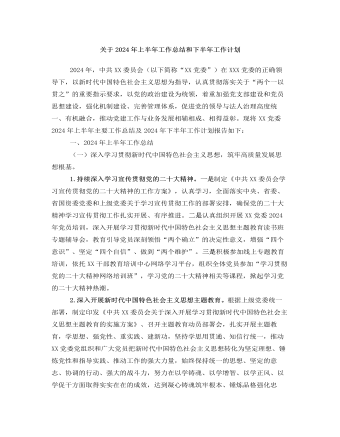
关于2024年上半年工作总结和下半年工作计划
二是深耕意识形态。加强意识形态、网络舆论阵地建设和管理,把握重大时间节点,科学分析研判意识形态领域情况,旗帜鲜明反对和抵制各种错误观点,有效防范处置风险隐患。积极响应和高效落实上级党委的决策部署,确保执行不偏向、不变通、不走样。(二)全面深化党的组织建设,锻造坚强有力的基层党组织。一是提高基层党组织建设力量。压实党建责任,从政治高度检视分析党建工作短板弱项,有针对性提出改进工作的思路和办法。持续优化党建考核评价体系。二是纵深推进基层党建,打造坚强战斗堡垒。创新实施党建工作模式,继续打造党建品牌,抓实“五强五化”党组织创建,广泛开展党员教育学习活动,以实际行动推动党建工作和经营发展目标同向、部署同步、工作同力。三是加强高素质专业化党员队伍管理。配齐配强支部党务工作者,把党务工作岗位作为培养锻炼干部的重要平台。
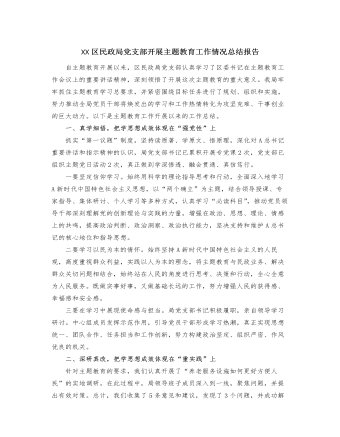
XX区民政局党支部开展主题教育工作情况总结报告
二要专注于解决问题。根据市委促进经济转型的总要求,聚焦“四个经济”和“双中心”的建设,深入了解基层科技工作、学术交流、组织建设等方面的实际情况,全面了解群众的真实需求,解决相关问题,并针对科技工作中存在的问题,采取实际措施,推动问题的实际解决。三要专注于急难愁盼问题。优化“民声热线”,推动解决一系列基层民生问题,努力将“民声热线”打造成主题教育的关键工具和展示平台。目前,“民声热线”已回应了群众的8个政策问题,并成功解决其中7个问题,真正使人民群众感受到了实质性的变化和效果。接下来,我局将继续深入学习主题教育的精神,借鉴其他单位的优秀经验和方法,以更高的要求、更严格的纪律、更实际的措施和更好的成果,不断深化主题教育的实施,展现新的风貌和活力。
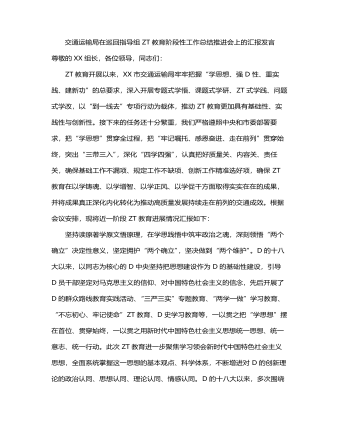
交通运输局在巡回指导组主题教育阶段性工作总结推进会上的汇报发言
今年3月,市政府出台《关于加快打造更具特色的“水运XX”的意见》,提出到2025年,“苏南运河全线达到准二级,实现2000吨级舶全天候畅行”。作为“水运XX”建设首战,谏壁闸一线闸扩容工程开工在即,但项目开工前还有许多实际问题亟需解决。结合“到一线去”专项行动,我们深入到谏壁闸一线,详细了解工程前期进展,实地察看谏壁闸周边环境和舶通航情况,不断完善施工设计方案。牢牢把握高质量发展这个首要任务,在学思践悟中开创建功之业,坚定扛起“走在前、挑大梁、多做贡献”的交通责任,奋力推动交通运输高质量发展持续走在前列。以学促干建新功,关键在推动高质量发展持续走在前列。新时代中国特色社会主义思想着重强调立足新发展阶段、贯彻新发展理念、构建新发展格局,推动高质量发展,提出了新发展阶段我国经济高质量发展要坚持的主线、重大战略目标、工作总基调和方法论等,深刻体现了这一思想的重要实践价值。
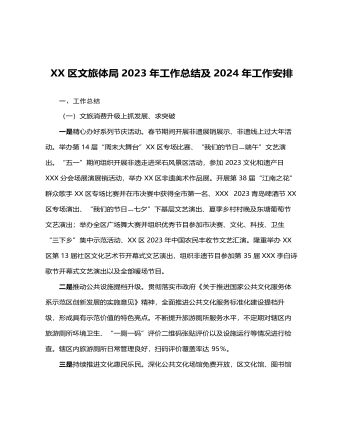
XX区文旅体局2023年工作总结 及2024年工作安排
三、2024年工作计划一是完善基层公共文化服务管理标准化模式,持续在公共文化服务精准化上探索创新,围绕群众需求,不断调整公共文化服务内容和形式,提升群众满意度。推进乡镇(街道)“114861”工程和农村文化“121616”工程,加大已开展活动的上传力度,确保年度目标任务按时保质保量完成。服务“双减”政策,持续做好校外培训机构审批工作,结合我区工作实际和文旅资源优势,进一步丰富我市义务教育阶段学生“双减”后的课外文化生活,推动“双减”政策走深走实。二是结合文旅产业融合发展示范区,全力推进全域旅游示范区创建,严格按照《国家全域旅游示范区验收标准》要求,极推动旅游产品全域布局、旅游要素全域配置、旅游设施全域优化、旅游产业全域覆盖。
今日更新Word
-

精选高中生期末评语
1、该生学习态度端正 ,能够积极配合老师 ,善于调动课堂气氛。 能够积极完成老师布置的任务。学习劲头足,听课又专注 ,做事更认 真 ,你是同学们学习的榜样。但是,成绩只代表昨天,并不能说明你 明天就一定也很优秀。所以,每个人都应该把成绩当作自己腾飞的起 点。2、 你不爱说话 ,但勤奋好学,诚实可爱;你做事踏实、认真、为 人忠厚 ,是一个品行端正、有上进心、有良好的道德修养的好学生。在学习上,积极、主动,能按时完成老师布置的作业,经过努力 ,各 科成绩都有明显进步,你有较强的思维能力和学习领悟力,学习也有 计划性,但在老师看来,你的潜力还没有完全发挥出来,学习上还要有持久的恒心和顽强的毅力。
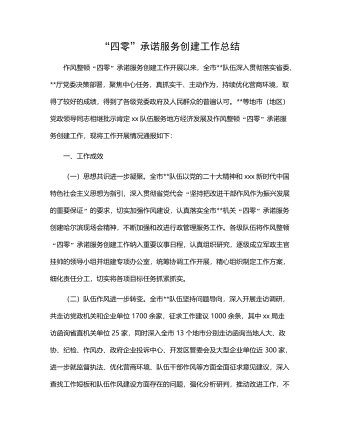
“四零”承诺服务创建工作总结
(二)坚持问题导向,持续改进工作。要继续在提高工作效率和服务质量上下功夫,积极学习借鉴其他部门及xx关于“四零”承诺服务创建工作的先进经验,同时主动查找并着力解决困扰企业和群众办事创业的难点问题。要进一步探索创新,继续优化工作流程,精简审批程序,缩短办事路径,压缩办理时限,深化政务公开,努力为企业当好“保姆”,为群众提供便利,不断适应新时代人民群众对政务服务的新需求。(三)深化内外宣传,树立良好形象。要深入挖掘并及时总结作风整顿“四零”承诺服务创建工作中形成的典型经验做法,进一步强化内部宣传与工作交流,推动全市创建工作质效整体提升。要面向社会和公众庄严承诺并积极践诺,主动接受监督,同时要依托电台、电视台、报纸及微信、微博等各类媒体大力宣传xx队伍作风整顿“四零”承诺服务创建工作成果,不断扩大社会知情面和群众知晓率。

2024年度工作计划汇编(18篇)
1.市政基础设施项目5项,总建设里程2.13km,投资概算2.28亿元。其中,烔炀大道(涉铁)工程施工单位已进场,项目部基本建成,正在办理临时用地、用电及用水等相关工作;中铁佰和佰乐(巢湖)二期10KV外线工程已签订施工合同;黄麓镇健康路、纬四路新建工程均已完成清单初稿编制,亟需黄麓镇完成图审工作和健康路新建工程的前期证件办理;公安学院配套道路项目在黄麓镇完成围墙建设后即可进场施工。2.公益性建设项目6项,总建筑面积15.62万㎡,投资概算10.41亿元。其中,居巢区职业教育中心新建工程、巢湖市世纪新都小学扩建工程已完成施工、监理招标挂网,2月上旬完成全部招标工作;合肥职业技术学院大维修三期已完成招标工作,近期签订施工合同后组织进场施工;半汤疗养院净化和医用气体工程已完成招标工作;半汤疗养院智能化工程因投诉暂时中止;巢湖市中医院(中西医结合医院)新建工程正在按照既定计划推进,预计4月中下旬挂网招标。

驻村工作队2024年第一季度工作总结汇编(4篇)
三是做大做强海产品自主品牌。工作队于xx年指导成立的冬松村海产品合作社,通过与消费帮扶平台合作,在工作队各派出单位、社会团体、个人支持下,已获得逾xx万元销售额。2022年底工作队推动合作社海产品加工点扩建的工作方案已获批,待资金下拨后将正式启动扩建工作。四是积极助企纾困,带动群众增收致富。工作队利用去年建立的xx镇产业发展工作群,收集本地企业在产品销售、技术、人力、资金、运营、用地等方面的需求,并加大xx支持乡村振兴力度,xx助理赴各村委开展多场xx政策支持乡村振兴宣讲活动,本季度有x万元助农贷款获批,xx万贷款正在审批中。在壮大既有产业的同时,完善联农带农机制,一方面鼓励企业雇用本地农户就业,另一方面计划与本地农户签订长期收购合同,让农民种得放心、种得安心,带动当地群众共同致富。

主题教育总结常用提纲大全
第一,主题教育是一次思想作风的深刻洗礼,初心传统进一步得到回归。第二,主题教育是一次沉疴积弊的集中清扫,突出问题进一步得到整治。第三,主题教育是一次强化为民服务的生动实践,赤子之情进一步得到提振。第四,主题教育是一次激发创业担当的有利契机,发展层次进一步得到提升。2.第一,必须提领思想、武装思想。第二,必须聚焦问题、由表及里。第三,必须领导带头、以上率下。第四,必须务实求实、认真较真。3.一是抬高政治站位,坚持大事大抓。二是坚持思想领先,狠抓学习教育。三是突出问题导向,深入整改纠治。四是坚持领导带头,发挥表率作用。4.一是立足“早”字抓筹划。二是着眼“活”字抓学习。三是围绕“统”字抓协调。5.一是形势所需。二是任务所系。三是职责所在。四是制度所定。6.一要提升认识。二要积极作为。三要密切协作。
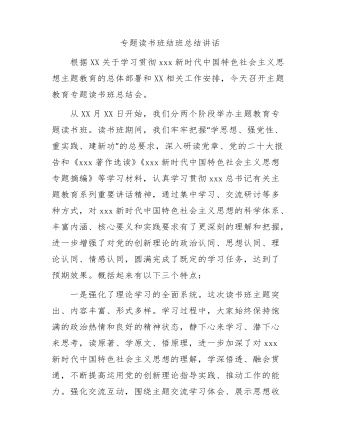
主题教育专题读书班结班总结讲话
第二,要把调查研究贯穿始终,实干担当促进发展。开展好“察实情、出实招”“破难题、促发展”“办实事、解民忧”专项行动,以强化理论学习指导发展实践,以深化调查研究推动解决发展难题。领导班子成员要每人牵头XX个课题开展调查研究,XX月底前召开调研成果交流会,集思广益研究对策措施。各部门、各单位要制定调研计划,通过座谈访谈、问卷调查、统计分析等方式开展调查研究,解决工作实际问题,帮助基层单位和客户解决实际困难。第三,要把检视问题贯穿始终,廉洁奉公树立新风。认真落实公司主题教育整改整治工作方案要求,坚持边学习、边对照、边检视、边整改,对标对表xxx新时代中国特色社会主义思想,深入查摆不足,系统梳理调查研究发现的问题、推动发展遇到的问题、群众反映强烈的问题,结合巡视巡察、审计和内外部监督检查发现的问题,形成问题清单。

















